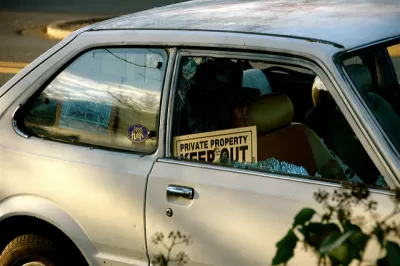The Salinas Valley in California is an agricultural powerhouse, but homelessness and hunger abound. Finding affordable housing is becoming increasingly difficult, even for people with jobs.

Brian Goldstone explores the California housing crisis through the story of a family, parents with three children, living out of their van in Salinas in Monterey County. As the region’s technology workers have moved into this part of the San Francisco Bay Area, housing costs have skyrocketed. "Over the past eight years, there has been a 37 percent loss of low-rent units in the city, while rents have shot up by almost 60 percent since 2014 — roughly four times the national average," he says.
The area’s working poor, including farmworkers employed in the area’s vast agricultural industry, are struggling with stagnant wages, immigration issues, and food insecurity. But housing, by far, is the greatest challenge they face, notes Goldstone. "Families are doubling and tripling up in overcrowded, substandard conditions; they’re resorting to garages and toolsheds, cars and abandoned properties. In Monterey County, approximately 8,000 schoolchildren were homeless last year, more than San Francisco and San Jose combined."
Homeless advocates say the federal counts of homeless people in the county is too low and, as a result, people do not get the resources they need. The family that Goldstone profiles eventually finds permanent housing after nine months of homelessness and living in the van. They are able to access a network of social services, including a program that helps them with the funds they need to rent a house, but the road to housing stability is a long and uncertain one.
FULL STORY: 3 kids. 2 paychecks. No home.

Alabama: Trump Terminates Settlements for Black Communities Harmed By Raw Sewage
Trump deemed the landmark civil rights agreement “illegal DEI and environmental justice policy.”

Study: Maui’s Plan to Convert Vacation Rentals to Long-Term Housing Could Cause Nearly $1 Billion Economic Loss
The plan would reduce visitor accommodation by 25% resulting in 1,900 jobs lost.

Why Should We Subsidize Public Transportation?
Many public transit agencies face financial stress due to rising costs, declining fare revenue, and declining subsidies. Transit advocates must provide a strong business case for increasing public transit funding.

Paris Bike Boom Leads to Steep Drop in Air Pollution
The French city’s air quality has improved dramatically in the past 20 years, coinciding with a growth in cycling.

Why Housing Costs More to Build in California Than in Texas
Hard costs like labor and materials combined with ‘soft’ costs such as permitting make building in the San Francisco Bay Area almost three times as costly as in Texas cities.

San Diego County Sees a Rise in Urban Coyotes
San Diego County experiences a rise in urban coyotes, as sightings become prevalent throughout its urban neighbourhoods and surrounding areas.
Urban Design for Planners 1: Software Tools
This six-course series explores essential urban design concepts using open source software and equips planners with the tools they need to participate fully in the urban design process.
Planning for Universal Design
Learn the tools for implementing Universal Design in planning regulations.
Smith Gee Studio
Alamo Area Metropolitan Planning Organization
City of Santa Clarita
Institute for Housing and Urban Development Studies (IHS)
City of Grandview
Harvard GSD Executive Education
Toledo-Lucas County Plan Commissions
Salt Lake City
NYU Wagner Graduate School of Public Service





























